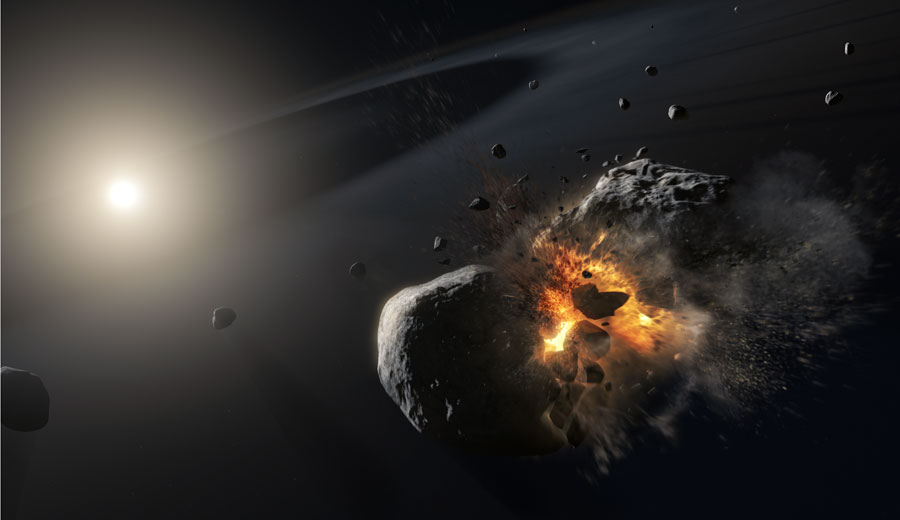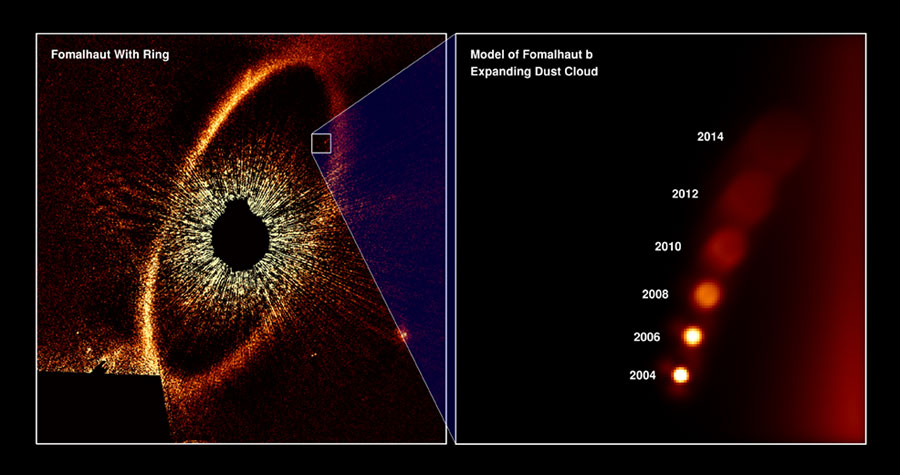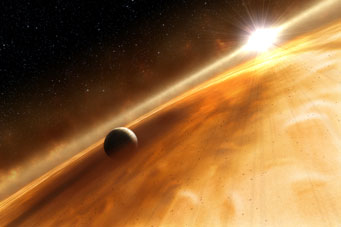Is Fomalhaut b “the planet that never was”? Astronomers continue to contest the nature of this object around a nearby star.
In 2008, astronomers discovered a planet 25 light-years away, orbiting the bright star Fomalhaut in Piscis Austrinus. But follow-up observations showed a picture that wasn’t nearly so simple.
Now, armed with previously unpublished observations and computer simulations, András Gáspár and George Rieke (both at University of Arizona) make the case in the Proceedings of the National Academy of Sciences that there’s no planet at all — just the dusty remains of a giant asteroid collision.

ESA / NASA / M. Kornmesser
Deciphering Fomalhaut b
The Fomalhaut system had been a target of exoplanet searches since 1993 in part because of its age — it’s relatively young at just 440 million years old — but especially because it radiates more infrared light than expected from the star alone. Over time, sharper images revealed an “Eye of Sauron” ring of warm dust encircling the star. The thin ring hints at giant “shepherding” planets that would have shaped its structure over time.
But when Paul Kalas (University of California, Berkeley) and colleagues captured Fomalhaut b in 2005, it turned out not to be one of those suspected shepherds. Instead, their Hubble Space Telescope images revealed a spot of visible light about 115 astronomical units (a.u.) from the star. It would be far out in the Kuiper Belt if it were orbiting the Sun.
The spot of light moved, proving it wasn’t a background star. But it didn’t appear in follow-up infrared observations, though, suggesting its mass was small. In fact, some infrared observations limited its mass to the point that astronomers began to wonder whether the visible light really came from a planet.
“Fomalhaut b is certainly one of the most intriguing discoveries ever made with the Hubble Space Telescope,” Kalas says. “However, Fomalhaut b is also one of the most difficult detections in the history of exoplanet science.” (For a fuller history, check out Kalas’s personal account of Fomalhaut b developments.)
Revisiting Old Ideas with New Data
Astronomers soon realized that a regular ol’ planet scattering its host star’s light couldn’t explain what they were seeing. Instead, they came up with two ideas. First, the object could be a smaller world still enshrouded in dust (or maybe it had even recently given birth to a system of moons).
Or, the object might not be a planet at all, just a transient puff of dust from a recent, violent collision.
Gáspár and Rieke fine-tuned the latter scenario as they analyzed previously unpublished Hubble images obtained in 2013 and 2014. These observations bring the total number to seven, taken with Hubble between 2004 and 2014. Tracking the object’s movement over a decade, Gáspár and Rieke find that it appears to be moving out of the system, elongating slightly as it does so. They also find that the object has faded out of view by 2014.

NASA / ESA / A. Gáspár and G. Rieke (University of Arizona)
“The observable characteristics cannot be brought into agreement with a planetary model for the object,” Gáspár says. So, he and Rieke proposed a spectacular crash between two large asteroids, both bigger than 200 kilometers (125 miles) across. While larger fragments largely continued their orbit, radiation pressure from the star blew away the smaller dust particles, giving the object its extended appearance.
Overall, the puff-of-dust scenario explains the object’s trajectory better than the dust-enshrouded planet scenario does, but the difference between the two is small.
A Matter of Luck?
“András Gáspár has an impressive model of what happens when two planetesimals collide,” Kalas says. But there’s a catch: The explanation requires a bit of a lucky coincidence.
“At 440 million years old, planetary system formation is mostly done in all systems,” Gáspár explains. “Such a collision that we hypothesize, with bodies with radii more than 100 km, are indeed rare even in younger systems.”
But if such an event is rare, what’s the chance that astronomers would have just caught it? “The planetesimal collision that could create a Fomalhaut b dust cloud would happen once every 100,000 years and the dust cloud can only be seen for 10 years,” Kalas points out. Indeed, Gaspar and Rieke calculate the collision happened just 39 days before the first observations. “Was I really the luckiest astronomer in the world when I pointed the Hubble Space Telescope at Fomalhaut?” Kalas asks.
“This is one of the reasons why such a model was not necessarily favored in the first few years after the discovery of Fomalhaut b,” Gáspár acknowledges. Nevertheless, he says, the puff-of-dust scenario explains all of the observations, “and sometimes you do get lucky and observe a rare event,” he adds.
“The model is plausible and a reasonable attempt to explain the observations,” says Scott Kenyon (Center for Astrophysics, Harvard & Smithsonian), who has proposed a similar idea in the past, though he too acknowledges that the new model requires a bit of luck.
Some things might make violent collisions more common. For example, migrating giant planets could stir up objects in this system’s version of the Kuiper Belt, making hits more likely. It’s hard to know, though, without more data.
We Need More Data
“The dust-cloud hypothesis is now riding on a single Hubble observation made seven years ago,” Kalas says. “I have asked for Hubble Space Telescope time to re-observe Fomalhaut in 2020-2021 to validate the dust-cloud hypothesis.”

ESA / Hubble (M. Kornmesser) / ESO (L. Calçada & L. L. Christensen)
“I certainly would not mind our model being proven wrong,” Gáspár says. For his part, he thinks the object has faded too much to be seen by Hubble — but that doesn’t mean we shouldn’t try, as even an image that doesn’t show the object would still provide useful information.
Meanwhile, he will use the James Webb Space Telescope, when it launches in 2021, to look much more deeply at the system’s infrared emission. “Science evolves,” he notes, “as new observations and data are acquired.”
 0
0








Comments
You must be logged in to post a comment.